Maine Coast Fisherman, December 1959
CUNDY'S HARBOR, ME.
- South of
Brunswick, Me. lie the
Harpswells, jutting into Casco
Bay with their rocky, irregular
coast and myriad islands.
If you 'drive out from Brunswick, turning south at Cook's Comer just
beyond the Naval Air
Station, you'll cross a bridge-at "the Gurnets" and
find yourself on an island
shaped. somewhat like a huge, twin-tailed horseshoe-
crab: It's
Sebascodegan, or Great
Island. All the Harpswells -consist of (from west to east)
Harpswell Neck, Bailey Island,
Orr's
Island, and Sebascodegan.
When you
cross the bridge at Gurnets, you're on Route 24, which, if you take
it straight, will lead to Land's End on Bailey. But if you turn off
to the left on an unnumbered route, you slip down to a point on
Sebascodegan where the little village of Cundy's Harbor suns itself
on good days on the rocky-shores of the New Meadows River.
NEARLY 100 PER CENT
FISHING
No one knows just where Cundy's Harbor begins or ends. It depends
on to how you look at it. The sea boundaries are easy, but by land
some favor one boundary, some another. Anyway, it's all in the Town
of Harpswell; and all of Sebascodegan makes up East Harpswell,
presided over by Selectman Gustavus (Gus) O. Gatchell of Pinkham
Point for the past 21 years.
Cundy's
is almost 100 per cent fishing, the lobster part of it representing
about 5,000 traps.
Many of
the boats are docked in the tiny cove of Oakhurst Island, just west
of the village and accessible by road. A current roster of a few of
the boats and owners includes:
Rebecca H, Merton Darling,, and St. Joseph II, Daniel and Bee
Darling, both draggers equipped with gear for flatfish, groundfish,
shrimp, and whiting dragging; Sea Cloud, Clyde Westcott, and Barbara
L., Walter Toothacre, both herring seiners; Madelyn C., David
Darling; Three-in-One, Charles Goodwin; Leola, Maurice Darling; Vida
E., Ernest Morgan; Navajo, Clifton Morgan; Drift-Wood, John Morgan;
Rebecca I, Merton Darling; Kandy, William Ganske; Big Jo, Freeman
Davis; Jeanette F., Dana York; and other excellent no-namers owned
by John Eastman, John Eastman, Jr., and Wesley Alexander.
ICE. CREAM TO BOAT LETTERS
Cundy's, named after William Condy, who settled there in 1733, is a
quiet village.' You'd
think there was nothing going on. You'll see boats
in the harbor, but most of the men will be out hauling traps, or
dragging for flatfish, groundfish, shrimp, or whiting, depending on the
time of year. If you drop in at Watson's General Store, you'll find Sid
Watson presiding at the counter, ready to sell you anything from ice
cream to life jackets and plastic boat letters.
Sid's great-grandfather set sail in a schooner
from Gloucester, Mass., with his family and all his goods, bound for
Boothbay Harbor. That was about 90 years ago. Beleaguered by a severe
storm, the great-grandfather, Robert Watson, sought refuge up the New
Meadows River and anchored in
Cundy's Harbor. After the storm broke, Sidney, his son, decided to stay
at Cundy's with his family. Father Robert went on to Boothbay, where
many of his descendants still live. For five generations, the eldest
sons of the Watsons have alternated with the name Robert and Sidney; so
the present Sid Watson's oldest son, 13, is named Robert, the 5th
generation at Cundy's. Originally, Cundy's peninsula was
settled by farmers, but Sid's grandfather engaged in the saltfish
business and founded Watson's General Store.
Besides running the store,. the present Sid has a
lobster business on a small scale, buying from 8 to 10 lobster
fishermen. He says the lobster business is not what it used to be,
because of competition and the fact that lobsters don't seem to be
rugged as formerly and don't survive as well.
HOLBROOK'S: WINTER SOCIAL CENTER
A little farther south, you'll
come to Holbrook's Store and Wharf right -at the end of the public -
road. You'll be greeted there by Mrs. Christine Miller, -store owner and
postmaster, whose father, Edward Holbrook, bought the store from Albert
Ridley in 1908 and ran it until his death in 1953. In the early 1900's,
the store and-wharf did a big salt fish and grocery business, people
coming across the New Meadows River - from Phippsburg and Sebasco to do
their trading. Today, however, because of increased transportation
facilities, 90 per cent of Mrs. Miller's business is in lobsters. She
can. store about 10,000 pounds at once, turning over about 100 tons a
year. At the peak' of the season,
she buys from about 25 -fishermen, and from five or six -in the winter.
-' .
PACE SLOW AND COMFORTABLE
. Again, take the new Community Hall and Fire
Station. About seven years ago, the
need for such facilities was
so great'
that about ten
towns got together and signed a
note in order to provide this building, whose exterior was completed
five years ago. About a year ago, with the feeling that the building was
not amortizing fast enough the women of the town got'~together and
formed the Cundy's Harbor Volunteer Firemen's Auxiliary. Their purpose,
which has been well realized, was to raise money by suppers and other
affairs for the building.
The people of Cundy's are
happy. They are also genuine plain, ordinary intelligent people. There
is a quiet take-us-or-leave us attitude, but it is gentle and based on
kindness, not flaunted in your face. There seems to be a reason for
everything in Cundy's, a lack of aimless- drifting, yet the pace is slow
and comfortable.

TWO DRAGGERS, the Rebecca H
and the St. Joseph II, the former owned by Merton Darling and the latter
by Daniel and "Bee" Darling, lie side by side just off Ridley Channel.
The mooring is on the Oakhurst Island side of Cundy’s. These draggers
are used for flatfish, groundfish, shrimp and whiting. Two seiners and a
number of lobster boats are included in the village fleet.
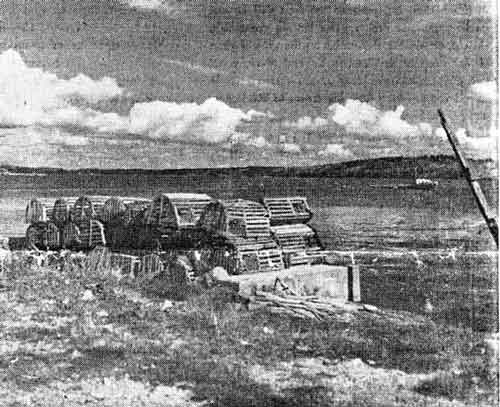
THE NEW MEADOWS RIVER
is broad and peaceful in northeast. An estuary reaching well. Inland,
ratfier than a brook above tide water. No matter where one wanders pile
of lobster traps.

THE YOUNGSTERS have a good
time, too. These children in the sub-primary and primary grades include
Gail Lucas, Susan Purinton, Robert Anderson, Kelvin Wilson, Patricia
Lucas, Herbert Morgan. David Blanchette and Barbara Dunning. Mrs. Ronald
Huston and Mrs. Eva Warren, the teachers, are about to ring the bell.
|

EARL WORRY'S FISH HOUSE
is one of the few along the Cundy shore. It is located between
Holbrook's and Watson's stores near the center of the village. While
such docks are pleasant scenic attractions, their use in this fishing
village is utilitarian only, the local people being more concerned with
'fishing-than in catering to summer visitors.

PART OF THE VILLAGE rising
steeply above the harbor can be seen over the bow of freeman Davis's
lobster boat. The large Richard Hatch home on the hilltop offers a
superb view of surrounding waterways.
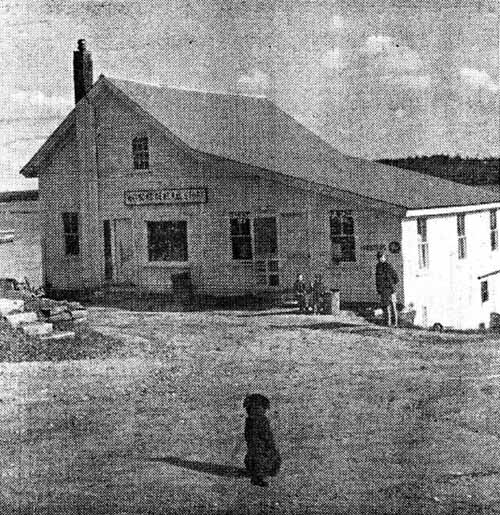
A DOG NAMED PATCHES appears to enjoy being coaxed
by Sidney Watson, owner of Watson's General Store. Stephen Davis and
Watson's son, Thomas, (the fifth generation of his family in Cundy's),
look on with great interest.
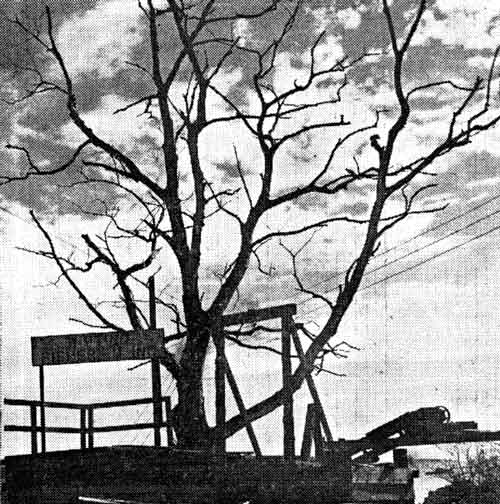
WATSON'S WHARF, once leased by Whiting Fisheries,
Inc., is now as dead as the lifeless tree that marks the spot. There is
talk of reviving business at this site in the form of a freezer plant.
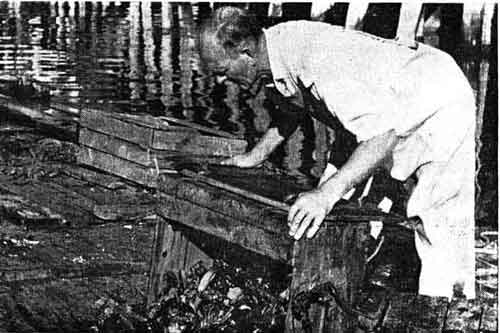
INTO THE CAR on Holbrook's
wharf goes a crate of lobsters, dumped there by Ivan Bowie. These
storage facilities, owned by storekeeper Mrs. Christine Miller, can
handle 10,000 pounds of lobsters at one time. About 100 tons of lobsters
go through Holbrook's cars each year. Mr& Miller buys from only six or
seven fishermen in the winter, although the number may go as high as 25
in the summer.
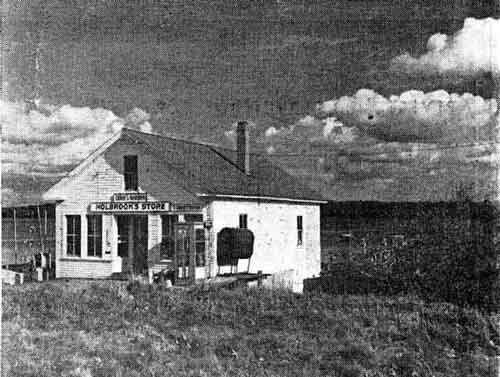
HOLBROOK'S STORE is an excellent example of, a.tr
once did a large grocery business when people,cgme, acres to purchase
their supplies. In, contrast, about 99 per, cent retail We of lobsters.
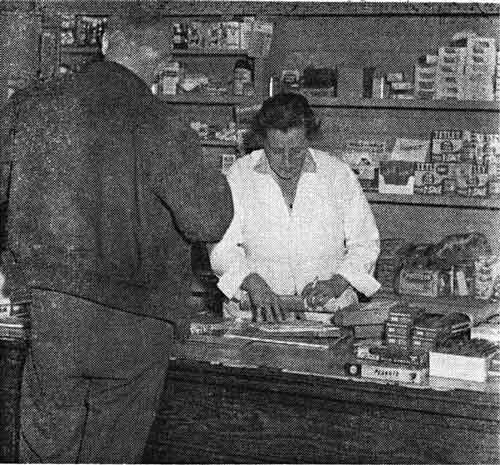
DOUBLE DUTY is one way to
describe the work of Mrs. Christine Miller, owner of store and wharf.
Since the post office is located in her store, she serves as
postmistress Here she looks over the mail before Robert Simson, mailman,
starts his rounds.

THE OUTBOARD MOTOR is
popular at Cundy's, too, and is used more and more for sport and
commercial fishing. Here Paul Tiemer, a former summer resident, now
living in the village year round, gets underway from Holbrook's wharf. A
variety of craft, ranging from rowboats to draggers, is based at the
harbor and nearby Oakhurst Island.
|












